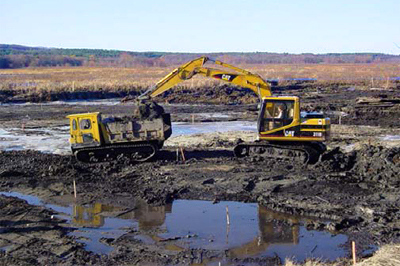by Shannon Piecuch
Raising food naturally is not a new concept. For years, farmers have been taking a stand against commercial food producers by refusing to use pesticides, chemical fertilizers, artificial growth hormones, and other conventional methods of raising crops and animals. All-natural and organic foods are promoted as being healthier than regular food, and are generally viewed as being environmentally-friendly. But sustainable farming is a step beyond simply not using chemicals in food production. In addition to producing food in a way that mimics nature, that is, without using lots of chemicals and artificial substances to increase production, this method of farming tries to create a system that is as self-sustaining as possible. In the 1990 Farm Bill, the official definition of sustainable agriculture used by the U.S. Department of Agriculture (USDA) is:
an integrated system of plant and animal production practices…that will, over the long term, satisfy human food and fiber needs, enhance environmental quality and the natural resource base upon which the agricultural economy depends, make the most efficient use of nonrenewable resources and on-farm resources and integrate where appropriate natural biological cycles and controls, sustain the economic viability of farm operations, and enhance the quality of life for farmers and society as a whole. (USDA, 2007)
In other words, sustainable agriculture takes into account the environment that produces the food and the society that eats the food, as well as actually producing the food.
It might be easiest to think of sustainable farming as it applies to growing crops, but it’s just as important to transfer these practices to raising livestock too. This means raising the animals solely on pasture instead of the conventional practice of sending them to feedlots before slaughter. Animals raised solely on pasture are termed ‘grass-fed’, as opposed to the ‘grain-fed’ animals on the feedlots that produce the majority of the meat that consumers buy.
The beef industry is a large factor in issues of feeding livestock grain versus feeding them grass, partly because beef operations are among the country’s largest livestock operations, and also because of the huge popularity of beef in this country. All cattle are initially raised on pasture, but almost all are sent to feedlots before slaughter, where they spend “100-200 days” (Umberger, Feuz, & Calkins, 2002, p 492) eating a high-energy, concentrated grain-based (usually corn) diet that rapidly puts on weight. This is called ‘finishing’, and it gets the cattle up to slaughter weight. The difference between grass-fed and grain-fed is that grass-fed cattle are never sent to a feedlot, but are instead finished on pasture on a grass-based diet. This might seem like simply a matter of preference, two different ways of doing things, but grass-fed beef has significant advantages over grain-fed beef. It has distinct health benefits, and the sustainable farming practices used to produce grass-fed beef are much better for the environment. It’s also much more economically feasible than might be assumed. For these reasons, the beef industry should shift towards using sustainable farming to maintain pastures and produce grass-fed beef instead of running feedlots and producing grain-fed beef.
The three main health advantages that grass-fed beef has over grain-fed beef are higher amounts of omega-3 fatty acids in relation to omega-6 fatty acids, a higher conjugated linoleic acid (CLA) content, and a much reduced risk of E. coli contamination. According to Leheska et al. (2008) in a study of the nutritional differences between grass-fed and grain-fed beef, omega-3 fatty acids “protect against coronary heart disease…and help lower blood pressure” (p. 3583), promoting overall heart health. In his book The Omnivore’s Dilemma, Michael Pollan (2006) states that omega-3 fatty acids have also recently been shown to play a role in the development and overall health of brain cells (p. 267). Omega-6 fatty acids, on the other hand, have been linked to increasing the risk of heart disease (Manning, 2009, p 49), essentially the opposite of omega-3 fatty acids. Leheska et al. (2008) briefly discuss the need for a balance between the two, as they both belong to the essential fatty acids group (p. 3583). As with cholesterol, some amount of omega-6 is necessary, but too much causes problems. Both Leheska et al. (2008) and Pollan (2006) mention the omega-6:omega-3 ratio as an easy way to examine the levels and balance of these two fatty acids (Leheska et al., 2008, p 3583), and that sometimes this ratio might be more important than the actual amounts of each fatty acid (Pollan, 2006, p 268). Grass-fed beef contains more omega-3 fatty acids and less omega-6 fatty acids (McCluskey et al., 2005, p 1), thus lowering the ratio from 10:1 or higher in grain-fed beef to around 2:1 (Pollan, 2006, p 269). CLA is a fatty acid that reduces the risk of heart disease (Manning, 2009, p 49). Recent studies have shown that it also has cancer-fighting properties (Long 2000). Grass-fed beef has much higher levels of CLA than grain-fed beef, which often contains no CLA at all (Long 2000). The significantly higher content of omega-3 and CLA makes grass-fed beef much more heart-healthy than grain-fed beef, and gives it the additional benefit of boosting the body’s defenses against cancer.
Pollan (2006) also describes cows as acting as a natural defense against E. coli infection in humans. The pH in a cow’s rumen, the part of their stomach that breaks down food, is neutral, so any E. coli bacteria present in their stomachs is adapted to that neutral pH. If humans ingest these E. coli, the acidity of our stomachs kills the bacteria. This only works, however, when the cows are fed grass. Feeding cattle only corn for any length of time increases the acidity of the rumen until it’s almost as acidic as human stomachs. Any E. coli bacteria that survive a corn-fed cow’s stomach are now acid-resistant, and will most likely survive the acid in our stomachs, going on to infect whoever ingests them. (Pollan, 2006, p 82). Breaking this natural defense mechanism means that while the contamination of beef with harmful E. coli bacteria can happen at any point along the production line of the beef, a major source is the cows themselves: because of their diets on the feedlot, harmful E. coli can already be in their guts, and if it makes it into the beef when the cattle are slaughtered, the contamination is in the meat from the beginning. Therefore, keeping cows on pasture and finishing them on grass instead of at feedlots eliminates a major source of E. coli bacteria contaminants.
The main environmental benefits of grass-fed beef come from converting cropland into permanent pasture. However, one of the first arguments against grazing large numbers of cattle is that they damage the land. In an article in Mother Earth News about converting cropland to pasture, Richard Manning (2009) stresses that overgrazing should not be confused with intensive grazing. Beef cattle consume massive amounts of corn; over half of the country’s grain crop is used to feed livestock. So, converting a large number of cattle from grain-fed to grass-fed necessitates converting cropland to pasture, otherwise farmers would quickly run out of land and the amount of excess corn would increase drastically, destroying the market. Overgrazing is a valid concern, but intensive grazing uses rotational grazing to divide the total pasture area into smaller segments, allowing each segment to recover after grazing before being used again. Grazing the land this way stimulates new grass growth, promotes biodiversity of plant species, and helps control weeds. (Manning, 2009, pp 50-51). This improves the quality of the grass, which in turn improves the quality of the beef.
Furthermore, the plains grasses that are native to most of the areas in the Midwest that now grow corn have deeper root systems than the row crops that replaced them (Manning, 2009, p 53). Repeatedly growing row crops year after year has depleted the topsoil of nutrients and organic matter. The soil of the grassland in the Midwest was originally around 10% organic matter, a percentage that has been cut in half over the last century (Manning, 2009, p 53). The grasses build a large root system to support the plant, and when cattle graze and eat the top part of the grass, there is no longer enough energy to support this root system, so it sheds the root system for a smaller one and grows back the larger roots as the plant grows back. The discarded root system adds to the organic matter in the soil and enriches it. (Manning, 2009, p 53). The deeper root system of grasses allows it to reach beyond the depleted topsoil so it can grow in the first place, then starts replenishing the organic matter and nutrients in the soil as the pasture is grazed, slowly increasing the quality of the soil. One critical advantage of better quality soil is the soil’s ability to absorb more water. Plowed fields can only absorb about 1.5 inches of rain per hour, whereas permanent pasture can absorb up to 7 inches of rain per hour (Manning, 2009, pp 52-53). Converting plowed fields to pasture would greatly reduce the risk of damaging floods in the Midwest.
Another important aspect of converting cropland to pasture is the potential to significantly decrease carbon emissions, and thereby to help reduce global warming. Carbon emissions are a big concern for agriculture: Pollan (2006) estimates that as much as one third of the greenhouse gases released into the atmosphere by human activity can be attributed to agriculture (p. 198). Manning (2009) explains how this happens by discussing the carbon cycle in pastures. The organic matter content of soil indicates its carbon content: the higher the organic matter content, the more carbon is in the soil. Tilling fields for planting adds oxygen to the soil, which decays organic matter in the soil and releases it as carbon dioxide. Annual crops such as corn do absorb large amounts of carbon dioxide, but they release most of it right back into the atmosphere when they’re harvested and the downed stalks decay. Permanent pasture, on the other hand, absorbs large amounts of carbon dioxide and keeps it because the plants aren’t harvested and cut every year. (Manning, 2009, p 53). By replenishing the soil’s organic matter, pasture grasses essentially pull carbon dioxide from the atmosphere and store it in the soil as carbon in organic matter. According to Pollan (2006), “if the sixteen million acres now being used to grow corn to feed cows in the United States became well-managed pasture [for those cows], that would remove fourteen billion pounds of carbon from the atmosphere each year, the equivalent of taking four million cars off the road” (p. 198). Also, the net release of carbon from croplands per year is about equal to the net storage of carbon in pasture per year (Manning 2009, p 54). Therefore, even turning some of the cropland into permanent pasture would make a huge dent in carbon emissions.
Converting cropland into pasture would also decrease fuel consumption. Raising cattle on grass uses less fossil fuel than the current feedlot system, and Pollan (2006) says that organic farming in general uses one third less fossil fuel than conventional methods (p. 183). He points out that when calculating the amount of fuel that beef productions use, the amount of fuel that goes into producing the corn used to feed the cows on the feedlot must also be considered. There’s the fuel used to make the pesticides and operate the machinery to grow, harvest, and process the corn; the natural gas used to make the chemical fertilizer; and the fuel used to transport everything. Adding these together equals about .25-.33 gallons of oil for each bushel of corn, or about 50 gallons per acre (Pollan, 2006, p 45). And that’s just the corn that the cows eat at the feedlot. On top of that is the fuel used to ship the cows from the farm to the feedlot, and the fuel used to operate all the machinery on the feedlot, such as the machines that mix the feed (Pollan, 2006, p 74), the machines involved in manure removal and management (Pollan, 2006, p 79), and the machines used to spray the pens with water to try to minimize the dust kicked up because there are so many cows on the feedlot (Pollan, 2006, p 80). Pollan (2006) estimates that between the fuel used to produce the corn the cow eats and the fuel used to manage the cow, sending one cow through the conventional feedlot system consumes the equivalent of 35 gallons of oil, which is almost a barrel of oil (p. 84). Judging by these numbers, it’s no surprise that the food industry as a whole consumes almost one fifth of all the petroleum used in the U.S., which is about the amount consumed by the automobile sector (Pollan, 2006, p 183). Grass-fed beef farms use a fraction of the fuel that grain-fed beef operations do, just by grazing the cattle and not feeding them any corn. In addition, they don’t need to use fertilizer or pesticides on the pastures, and the cows are only shipped to the slaughter house instead of from the farm to the feedlot and then from the feedlot to the slaughterhouse. Changing beef productions from grain-fed to grass-fed could be used as an important factor in reducing the nation’s fuel consumption.
With so much evidence proving the extensive benefits of grass-fed beef, one would expect that farms that raised grass-fed beef would be much more common, and grass-fed beef wouldn’t be viewed as a specialty food but as an important segment of the beef industry. But grass-fed beef faces two major obstacles: consumers accustomed to the taste of corn-fed beef and consumers who want extremely cheap and convenient food. In contrast to popular belief, converting to grass-fed beef is definitely economically feasible. According to Manning (2009), many farmers who raise grass-fed cattle can finish about two cows per acre of pasture, which is almost exactly the acreage needed to grow the corn that those cows would eat at a feedlot. Also, once the pasture is established, many farmers see a higher profit from the grass-fed cattle than they did when they were growing corn. One main reason is a drastic reduction in costs for machinery, fuel, fertilizer, and pesticides. The only problem is that it takes 1-2 years for the cropland to recover from intensive use for crops and develop grass sufficient to finish high-quality beef; before the land is fully recovered it can’t be grazed at full capacity. (Manning, 2009, p 51) This means the farmers need an alternative means of income until the pasture is ready. Government programs to supplement income might be the answer, but the government isn’t going to initiate these programs by themselves. The beef industry, with its industrialized farming practices, is very good at producing very cheap meat and making it very convenient. A push for anything different needs to come from the consumers.
Two studies, Sitz et al. (2005) and Umberger et al. (2002), examined American consumers’ willingness to pay premiums for the beef they preferred, comparing domestic grain-fed beef with imported grass-fed beef; Sitz et al. (2005) compared domestic grain-fed beef with imported grass-fed beef from Australia, and Umberger et al. (2002) compared domestic grain-fed beef with imported grass-fed beef from Argentina. About 60% of the consumers in each study preferred the domestic beef and were willing to pay up to $2.23 more per pound for it (Sitz et al., 2005, p 2867; Umberger et al., 2002, p 491). There was, however, a sizeable portion that preferred the grass-fed beef, about 20% of the consumers in each study, and they were willing to pay as much as $1.38 more per pound (Sitz et al., 2005, p 2867; Umberger et al., 2002, p 491). Both studies note that factors such as the amount of marbling (intramuscular fat) in the meat, varying aging periods, the genetics and/or breed of the cattle, and different feeding practices contribute to and affect the flavor of the beef (Sitz et al., 2005, p 2868; Umberger et al., 2002, p 492). Common U.S. practice is to feed cattle corn and age the meat for a relatively short amount of time, which contributes to the particular corn-fed taste of domestic beef (Umberger et al., 2002, p 492). Management or production practices that differ from this will produce meat that tastes different. Some of the differences in these practices result from the meat needing to be stored and shipped internationally; for example, the grass-fed beef from Australia was aged for approximately seven times as long as domestic meat is normally aged because it had to be shipped internationally and stored longer (Sitz et al., 2005, p 2867). Raising grass-fed beef domestically would eliminate many of these differences and make the flavor differences between grass-fed and grain-fed beef solely due to feeding practices.
According to Sitz et al. (2005), American consumers prefer corn-fed beef because “a steady supply of corn-fed beef is available to most consumers in the United States, [so] consumers have become accustomed to the flavor of corn-fed beef” (p. 2868). We’re willing to pay $2 more for beef that we think tastes better but we’re not willing to pay more for beef that is healthier for us, and on top of that is better for the environment? Granted, the environmental benefits are more abstract than the health benefits that we can relate directly to our personal lives, but with all the buzz these days about ‘going green’, the environmental benefits should be a rallying point as well. It all comes down to one thing at which our economy excels: choice. The options are presented, but we each individually still have to make the choice. Choose to know where the food comes from and what happens to it between there and the dinner table. Choose to spend a little more for food that is of better quality and doesn’t come with so many hidden costs. Choose to support local farmers who grow and raise food naturally and help them stand up to the big corporate farms that are preventing the current system from changing. Choose to have beef three days a week instead of four to offset the cost of paying more for grass-fed beef. We have done so many detrimental things to the land that we are so dependent on, we can certainly afford to make a small sacrifice to work towards repairing the damage. Saying that the consumers drive the market might be oversimplifying things, but a large part of our economy is based on giving the consumers what they want. If we the consumers say we want the healthier, more environmentally friendly, more naturally produced grass-fed beef, then something’s got to give.
References
Leheska, J. M., Shriver, B., Brooks, J. C., Miller, M. F., Hoover, L., Howe, J. C., et al. (2008). Effects of conventional and grass-feeding systems on the nutrient composition of beef. Journal of Animal Science, 86(12), 3575-3585. Retrieved from Agricola, IND44131411.
Long, C. (2000). Factory farming is fouling our food. Organic Gardening (1988), 47 (6), 12-13. Retrieved from Biological & Agricultural Index, BBAI00070417.
Manning, R. (2009). The amazing benefits of grass-fed meat. Mother Earth News, (233), 48-56. Retrieved from GreenFILE, 40221543.
McCluskey, J. J., Wahl, T. I., Li, Q., & Wandschneider, P. R. (2005). U.S. grass-fed beef: Marketing health benefits. Journal of Food Distribution Research, 36, 1-8. Retrieved from Agricola, IND43887360.
Pollan, Michael. (2006). The omnivore’s dilemma: A natural history of four meals. New York, NY: Penguin Books.
Sitz, B. M., Calkins, C. R., Feuz, D. M., Umberger, W. J., & Eskridge, K. M. (2005). Consumer sensory acceptance and value of domestic, Canadian, and Australian grass-fed beef steaks. Journal of Animal Science, 83, 2863-2868. Retrieved from Agricola, IND43759770.
Umberger, W. J., Feuz, D. M., & Calkins, C. R. (2002). U.S. consumer preference and willingness-to-pay for domestic corn-fed beef versus international grass-fed beef measured through an experimental auction. Agribusiness, 18(4), 491-504. Retrieved from Biological & Agricultural Index, BBAI02113905.
USDA, Alternative Farming Systems Information Center. (updated August 2007). Sustainable agriculture: Definitions and terms. [Ed. Mary V. Gold]. National Agricultural Library Cataloging Record. Retrieved from www.nal.usda.gov




